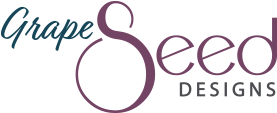You’re ready to officially launch a website — congratulations! It’s a big step in starting (or growing) your business. But if you’re new to hiring a web designer, it can be an intimidating process.
Here are a few steps to consider when hiring a web designer:
- portfolio
- coding skills and platform experience
- additional skills
- personality and communication style
1. Portfolio
You know you should look at a designer’s portfolio before hiring them. But what are you looking for?
Aesthetic
Designers often have a certain visual style across most (if not all) of their work. This allowing them to master style and work efficiently. Look at several of a designer’s projects and see if it fits what you like.
Quality of Work
Look for consistency, including colors, typography, and other visual language.
How well does the design communicate? If you have to really dig into a site to understand what it’s about, the design hasn’t done its job.
Simplicity speaks. If it’s complex it gets confusing. Look for simplicity that lets your brain get right to the important message(s).
Diversity and Alignment of Work
Designers often focus on a particular type of project (branding, web, apps, social media, etc). Consider a designer’s work and what they do most.
Industry Niche (optional)
Similarly, designers often focus on a particular industry or niche. This helps projects go smoother and faster, and may provide insights beyond your website.
Designer’s Role in Each Project
Designers often collaborate on projects; being in an artist’s portfolio doesn’t mean they produced the entire project. This could range from original branding to illustrations or photography. They may or may not have written content, or designed the site vs actually building in code.
2. Skills & Platform Experience
With website design especially, platform matters. You want to hire a web designer experienced with the platform(s) suited for your needs.
Wix, Shopify, Squarespace, or WordPress (oh my!)
Each has its strengths and unique interface for designing and building. You want a designer familiar with the platform you prefer.
Hand Coded vs WYSIWYG
The platforms above are WYSIWYG editors, capable of building with no coding skills at all.
However, designers without coding experience may not know how certain choices affect a site’s speed, security, or accessibility. It can also limit their ability to adapt themes to your precise needs. Consider a designer with both WYSIWYG and raw coding experience.
Raw code web developers build completely from scratch. This may be necessary for more complex web apps, or sites with unique usability requirements. Ask your designer if you think this applies to you.
3. Additional Skills
While designers often focus on a particular niche or aesthetic, extra experience may also benefit your final product.
These skills often come from a degree, transitioning from one niche to another, or working with larger teams.
Branding and Digital Design
While related to web design, these aren’t exactly the same. There are nuances to developing branding itself, as well as various types of digital collateral.
Print Collateral
Print and web have more differences than people realize. There are differences in color application, file setup, and other layout considerations. If you’re getting print collateral (brochures, book layouts, etc), ask about print experience.
Marketing
There are various aspects to marketing, including metrics and user journey or psychology. There are also various fields of marketing, such as digital/web, social media, print, local, television, and more.
Hiring a web designer with marketing experience helps create a site integrated with your overall strategy.
Social Media
Social media is its own beast, both with strategy and content (both written and visual). If you plan to use a social media, consider a designer with experience on your preferred platform(s).
Bear in mind, a designer is different than a social media manager. A designer will produce content (often alongside a copy writer). Managers execute strategy day to day, including planning and scheduling posts.
SEO
Folks assume a website includes SEO, but that’s not always true. To rank well in online search results, you need to hire a web designer who specializes SEO, or a dedicated SEO specialist in addition to your designer.
SEO includes many elements, but generally we look at structural vs ongoing. You want a designer who at least optimizes page titles, H1 tags, and images.
App Development
If you want an app, too, consider a designer who can carry branding across both platforms. Also remember — app designers and developers are rarely the same person.
Google Specializations
Several Google products can help your online presence (Google Business, Google Ads, Campaign Manager, and more). A designer’s familiarity with these products creates a more seamless cross-platform strategy, too.
4. Personality and Communication
Developing a site is a big undertaking, and you want to make sure you get along as a team.
Communication Style
Do you prefer digital communication, or face to face? Does your designer answer all your questions? How are files and ideas shared? All these things are important to communicating with your designer. Hire someone you feel good talking to.
Thought Process
If you don’t understand how decisions are made, the process can become frustrating quickly. Be sure you and your designer are on the same page, and you follow their thought process easily.
Other Considerations When Hiring a Web Designer
Different designers may have additional offerings to help make your site a success.
Do you need ongoing web maintenance?
How often will information about your business change? Do you have plugins that need regular updates (important for site security)?
Maintenance packages are often well worth alleviating the headache of making changes yourself.
Do you need additional collateral?
Consider whether you need social media collateral, newsletter designs, or print brochures. It’s often easier to get a package from one designer than to coordinate several. Be sure to ask what extras a designer can provide.

